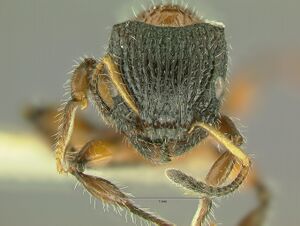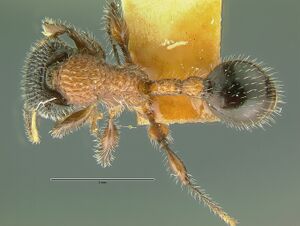Dilobocondyla fouqueti
| Dilobocondyla fouqueti | |
|---|---|

| |
| Scientific classification | |
| Kingdom: | Animalia |
| Phylum: | Arthropoda |
| Class: | Insecta |
| Order: | Hymenoptera |
| Family: | Formicidae |
| Subfamily: | Myrmicinae |
| Tribe: | Crematogastrini |
| Genus: | Dilobocondyla |
| Species: | D. fouqueti |
| Binomial name | |
| Dilobocondyla fouqueti Santschi, 1910 | |
| Synonyms | |
| |
Dilobocondyla fouqueti is distributed in Vietnam and China. All recent Hong Kong records are from mature patches of lowland forest. The species is uncommon, with only a handful of records from well-surveyed areas, and is at least partly arboreal (Bharti & Kumar, 2013).
Identification
There is noticeable colour variation in D. fouqueti and worker length is quite variable, ranging from 4.5 to 7.04 mm. (Bharti and Kumar 2013)
The species can be distinguished from other species of Dilobocondyla by the imperceptible hexagonal micro-reticulations. Its micro-reticulations on gasteral dorsum are also much more subtiler than other species, which can be easily observed (Chen, Li & Zhou, 2019).
Keys including this Species
Distribution
Latitudinal Distribution Pattern
Latitudinal Range: 29.566° to 18.86°.
| North Temperate |
North Subtropical |
Tropical | South Subtropical |
South Temperate |
- Source: AntMaps
Distribution based on Regional Taxon Lists
Oriental Region: Vietnam (type locality).
Palaearctic Region: China.
Distribution based on AntMaps
Distribution based on AntWeb specimens
Check data from AntWeb
Countries Occupied
| Number of countries occupied by this species based on AntWiki Regional Taxon Lists. In general, fewer countries occupied indicates a narrower range, while more countries indicates a more widespread species. |

|
Estimated Abundance
| Relative abundance based on number of AntMaps records per species (this species within the purple bar). Fewer records (to the left) indicates a less abundant/encountered species while more records (to the right) indicates more abundant/encountered species. |

|
Biology
Castes
Worker
   
| |
| . | Owned by Museum of Comparative Zoology. |
Nomenclature
The following information is derived from Barry Bolton's Online Catalogue of the Ants of the World.
- fouqueti. Dilobocondyla fouqueti Santschi, 1910h: 283 (w.) VIETNAM.
- Type-material: holotype worker.
- Type-locality: Vietnam: Tonkin, Hanoi (Fouquet).
- Type-depository: NHMB.
- Bharti & Kumar, 2013a: 40 (q.m.).
- Status as species: Santschi, 1920h: 160; Santschi, 1924c: 98; Emery, 1924d: 241; Wheeler, W.M. 1924b: 249 (in key); Chapman & Capco, 1951: 116; Wang, C. & Wu, 1992b: 562; Bolton, 1995b: 171; Wu, J. & Wang, 1995: 107; Zhou, 2001b: 136; Varghese, 2006a: 25; Guénard & Dunn, 2012: 43; Bharti & Kumar, 2013a: 40 (redescription); Chen, et al. 2019: 133.
- Senior synonym of lighti: Wang, C. & Wu, 1992b: 562; Bolton, 1995b: 171; Zhou, 2001b: 136; Varghese, 2006a: 25; Bharti & Kumar, 2013a: 40; Chen, et al. 2019: 133.
- Distribution: China, Vietnam.
- lighti. Dilobocondyla fouqueti var. lighti Wheeler, W.M. 1927d: 6 (w.) CHINA (Fujian).
- Type-material: holotype worker.
- Type-locality: China: Amoy (S.F. Light).
- Type-depository: MCZC.
- Subspecies of fouqueti: Wheeler, W.M. 1930h: 69; Chapman & Capco, 1951: 116.
- Junior synonym of fouqueti: Wang, C. & Wu 1992b: 562; Bolton, 1995b: 171; Zhou, 2001b: 136; Varghese, 2006a: 25; Bharti & Kumar, 2013a: 40; Chen, et al. 2019: 133.
Unless otherwise noted the text for the remainder of this section is reported from the publication that includes the original description.
Description
Worker
Bharti and Kumar (2013) - HL 1.30-1.51; HW 1.33-1.51; ED 0.30-0.33; SL 0.80-0.95; MFC 0.62-0.73; PRNW 0.95-1.11; ML 1.90-2.37; PTL 0.68-0.79; PTW 0.28-0.37; PTH 0.31-0.37; PPTL 0.51-0.62; PPTW 0.40-0.50; PPTH 0.37-0.47; GL 1.44-1.75; CI 100.00-102.31; SI 60.15-63.70; PTWI 41.18-46.83; PPTWI 77.42-80.65; TL 5.83-7.04 (4 measured)
Head as long as broad, slightly broader posteriorly than in front, sides barely convex, posterior head margin with broad emargination; posterior corners blunt; mandibles with 6 teeth, masticatory margin of mandibles with large apical, preapical and basal tooth; clypeus flat, anterior border emarginate with a clear notch in the middle, sinuate at the corners; frontal area indistinct; antennae slender, 12-segmented with distinct 3-segmented club; scape slender, curved at the base, reaching up to 3/4 of head length; eyes large, placed at midlength of the head; mesosoma not broader than head; pro-mesonotal dorsum weakly convex, pro-mesonotal suture indistinct; pronotum broader than long, its anterior lateral angles acute; metanotal groove broad, shallow; dorsal face of propodeum gradually slanting towards declivity, basal part longer than declivitous part, propodeal lobes rounded; petiole elongate, length more than twice its width, with parallel sides, arcuate in profile, with a strong antero-ventral tooth; postpetiole longer than broad, posterior part broader than anterior part and forming a node; gaster broadly oval in dorsal view; legs with femora strongly incrassate and tibiae slightly thickened.
Head longitudinally rugose up to vertex, behind which more rugoreticulate, with 12 strong rugae between frontal carinae at the level of eyes; interrugal space punctured and shiny; frontal carinae divergent, long, prominent, continuing to posterior corners of the head; antennal scrobes deep; mandibles longitudinally costulate and rugulose, interrugal space smooth and shiny; clypeus with tiny rugulae posteriorly, shiny, with strong median and a pair of lateral carinae; sides of the head, mesosoma, petiole and postpetiole strongly rugoreticulate; anepisternum and metapleuron smooth and shiny, katepisternum rugoreticulate; propodeal declivity smooth and shiny; gaster smooth and shiny with the basal part of the first segment longitudinally striate; legs shiny, coxae punctured with transverse rugulae on fore coxae, femora smooth and tibiae finely longitudinally striate.
Mesosoma, petiole and postpetiole castaneous; head and gaster blackish brown, scape and legs yellowish brown; whole body covered with abundant, long, obtuse, whitish pilosity.
Queen
Bharti and Kumar (2013) - HL 1.53-1.59; HW 1.51-1.57; ED 0.33-0.35; SL 0.91-0.97; MFC 0.71; PRNW 1.28-1.33; ML 2.59-2.66; PTL 0.84-0.93; PTW 0.40-0.42; PTH 0.40; PPTL 0.70-0.73; PPTW 0.55-0.57; PPTH 0.50-0.51; GL 1.62-2.29; CI 98.74-98.69; SI 60.26-61.78; PTWI 45.16-47.62; PPTWI 75.34-81.43; TL 7.28-8.20 (2 measured)
Similar to worker except head slightly longer than broad, with three ocelli; mesonotum, katepisternum and scutellum longitudinally rugose while pronotum, anepisternum and metapleuron rugoreticulate; gaster yellowish brown except 1st and 2nd segment blackish brown.
Male
Bharti and Kumar (2013) - HL 1.06; HW 1.28; ED 0.39; SL 0.24; PRNW 1.04; ML 2.35; PTL 1.00; PTW 0.35; PTH 0.35; PPTL 0.86; PPTW 0.44; PPTH 0.46; GL 2.80; CI 120.75; SI 18.75; PTWI 35.00; PPTWI 51.16; TL 8.07 (1 measured)
Head much broader than long, sides convex, posterior head margin barely emarginate, with three ocelli; mandibles with well developed pointed teeth; clypeus convex, anterior margin rounded and entire; frontal area distinct, triangular; antennae 13-segmented, longer and without distinct club, funicular segments cylindrical and longer than broad; scape longer than 2nd segment but shorter than the rest of the segments; antennal scrobes deep; eyes large, convex and slightly below midlength of head; pronotum not broader than head, its anterior lateral angles acute; scutum broader than pronotum and divided into three plates, scutellum somewhat rounded; dorsal face of propodeum flat and vertical; petiole longer, almost 2.9 times its width, with small blunt antero-ventral tooth; gaster convex, elongate; femora and tarsi less incrassate than in workers.
Head and mesosoma longitudinally rugoreticulate and spaces between them punctured and shiny; mandibles, clypeus and frontal area longitudinally rugose; frontal carinae short and not continuing to the posterior corners of the head; petiole and postpetiole faintly reticulate; gaster smooth; legs finely punctured and shiny; wings transparent.
Head, mesosoma, petiole, postpetiole and coxae blackish; antennae, legs and gaster yellowish brown; body covered with long erect and subdecumbent hairs except antennae, 1st gastral tergite, coxae, trochanters, femora and tibiae with short suberect hairs.
References
- Bharti, H.; Kumar, R. 2013. Five new species of Dilobocondyla (Hymenoptera: Formicidae) with a revised key to the known species. Asian Myrmecology 5:29-44.
- Cantone S. 2018. Winged Ants, The queen. Dichotomous key to genera of winged female ants in the World. The Wings of Ants: morphological and systematic relationships (self-published).
- Chen, Z., Li, W., Zhou, S. 2019. Taxonomic review of the ant genus Dilobocondyla from China (Hymenoptera: Formicidae), with a revised key to the known species. Zoological Systematics 44(2): 132–139 (doi:10.11865/zs.201908).
- Khachonpisitsak, S., Yamane, S., Sriwichai, P., Jaitrong, W. 2020. An updated checklist of the ants of Thailand (Hymenoptera, Formicidae). ZooKeys 998, 1–182 (doi:10.3897/zookeys.998.54902).
- Liu, C., Fischer, G., Hita Garcia, F., Yamane, S., Liu, Q., Peng, Y.Q., Economo, E.P., Guénard, B., Pierce, N.E. 2020. Ants of the Hengduan Mountains: a new altitudinal survey and updated checklist for Yunnan Province highlight an understudied insect biodiversity hotspot. ZooKeys 978, 1–171 (doi:10.3897/zookeys.978.55767).
- Santschi, F. 1910h. Deux nouvelles fourmis du Tonkin. Naturaliste 32: 283-284 (page 283, worker described)
- Wang, C.; Wu, J. 1992c. Ants of the Jianfengling forest region in Hainan Province (Hymenoptera: Formicidae). Sci. Silvae Sin. 28: 561-564 (page 562, Senior synonym of lighti)
References based on Global Ant Biodiversity Informatics
- Bharti H., and R. Kumar. 2013. Five new species of Dilobocondyla (Hymenoptera: Formicidae) with a revised key to the known species. Asian Myrmecology 5: 29-44.
- Chen Z., W. Li, and S. Zhou. 2019. Taxonomic review of the ant genus Dilobocondyla from China (Hymenoptera: Formicidae), with a revised key to the known species. Zoological Systematics 44(2): 132–139.
- Cheng D., Z. Chen, and S. Zhou. 2015. An analysis on the ant fauna of Jinzhongshan Nature Reserve in Gunagxi, China. Journal of Guangxi Normal University: Natural Science Edition 33(3): 129.137.
- Eguchi K.; Bui T. V.; Yamane S. 2011. Generic synopsis of the Formicidae of Vietnam (Insecta: Hymenoptera), part I Myrmicinae and Pseudomyrmecinae. Zootaxa 2878: 1-61.
- Guénard B., and R. R. Dunn. 2012. A checklist of the ants of China. Zootaxa 3558: 1-77.
- Hua Li-zhong. 2006. List of Chinese insects Vol. IV. Pages 262-273. Sun Yat-sen university Press, Guangzhou. 539 pages.
- Li Z.h. 2006. List of Chinese Insects. Volume 4. Sun Yat-sen University Press
- Liu X. 2012. Taxonomy, diversity and spatial distribution characters of the ant family Formicidae (Insecta: Hymenoptera) in southeastern Tibet. PhD Thesis 139 pages
- Liu X., Z. Xu, N. Yu, and C. Zhang. 2016. Distribution patterns of ant species ( Hymenoptera: Formicidae) in Galongla Mountains and Medog Valley of Southeastern Tibet. Scientia Silvae Sinicae 52(11): 88-95.
- Santschi F. 1920. Fourmis d'Indo-Chine. Annales de la Société Entomologique de Belgique 60: 158-176.
- Santschi F. 1924. Fourmis d'Indochine. Opuscules de l'Institut Scientifique de l'Indochine 3: 95-117
- Shuang Zhao. 2006. Ant of Guangdong Province (Hymenoptera: Formicidae): A taxonomic study of the ants of Guangdong (Hymenoptera: Formicidae). Master's thesis in Agriculture Insects and Pest Control. Supervisor Fenglong Jia. 115 pages.
- Staab M., A. Schuldt, T. Assmann, H. Bruelheide, and A.M. Klein. 2014. Ant community structure during forest succession in a subtropical forest in South-East China. Acta Oecologia 61: 32-40.
- Staab M., J. Methorst, J. Peters, N. Bluthgen, and A. M. Klein. 2017. Tree diversity and nectar composition affect arthropod visitors on extrafloral nectaries in a diversity experiment. Journal of Plant Ecology 10(1): 210-212.
- Wang C. and Wu J.. 1992. Ants of the Jianfengling forest region in Hainan Province (Hymenoptera: Formicidae). Scientia Silvae Sinicae 28: 561-564.
- Wheeler W. M. 1927. Chinese ants collected by Professor S. F. Light and Professor N. Gist Gee. American Museum Novitates 255: 1-12.
- Xu Z. H., B. L. Yang, and G. Hu. 1999. Formicidae ant communities in fragments of montane rain forest in Xishuangbanna, China. Zoological Research 20(4): 288-293.
- Xu Z., Zeng G., Liu T.-Y. and He Y.-F.. 1999. [A study on communities of Formicidae ants in different subtypes of vegetation in Xishuangbanna District of China.] Zoological Research 20: 118-125
- Zhang R. J., L. W. Liang, and S. Y. Zhou. 2014. An analysis on the ant fauna of Nonggang Nature Reserve in Guangxi, China. Journal of Guangxi Normal university: Natural Science Edition 32(3): 86-93.
- Zhou S.-Y. 2001. Ants of Guangxi. Guangxi Normal University Press, Guilin, China, Guilin, China. 255 pp.

